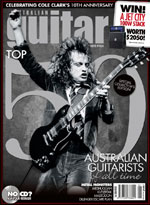SHREDDED METAL
POWER CHORDS AND DYADS
The humble power chord is a staple of heavy metal rhythm guitar. Oftentimes, nothing feels better than cranking up a Marshall and ‘chunking’ out a low E5! Whilst power chords are by far the most common chords used in metal, the music theory behind them is often overlooked by metal musicians. For this column, rather than discuss flashy ‘shred’ guitar licks, I want to explain how power chords are constructed, as well as some different variations.
EXERCISE 1
A power chord is built from the first and fifth notes of a major (or natural minor) scale. As such, they are often referred to as ‘root/fifth’ power chords. What makes them interesting is that they do not contain the crucial third degree (the note that determines whether a chord is of a major or minor tonality). Therefore, power chords are ‘neutral’ or ‘undetermined’ chords. Power chords are so common in heavy metal since when played with heavy distortion, multiple string major/minor chords will sound messy and muddy, whereas power chords still sound crisp and clear. Exercise 1 illustrates some different ways of playing an E5 chord. In its simplest form, a power chord will consist of the root note as the lowest note (in pitch) and the fifth degree (bar 1). You can also double up the root note by playing the octave (bar 2). Power chords can easily be moved around to different keys by shifting the shape up and down the fretboard to the appropriate root note, and they can also be played on different groups of strings (bars 3 & 4: root fifth string, bars 5 & 6: root fourth string).

EXERCISE 2
An awesome power chord variation is to voice the fifth degree in the bass (bar 1). The chord would therefore be in first inversion (E5/B). This really adds some extra ‘grit’ to power chords that have the root note on the fifth string. It’s important to recognise here that although B is the lowest note, E is still the root (and if playing in a band, the bass guitar would play an E). The remaining chords are all dyads. A dyad is simply a two note chord. However, they can imply more complex three or four note chords. Dyads can be great for adding more colour to metal riffs (as opposed to just using power chords). Naming dyads can be a bit tricky, but I’ve used a naming system that hopefully makes sense. Depending on what note you consider the root, the dyad in bar 2 could either be considered an E5 in first inversion, or a B fourth interval. Bars 3 and 4 outline an augmented (#5) fifth and diminished fifth (b5) interval respectively. The last two bars are basic major and minor third dyad shapes.

EXERCISE 3
I’ve written a short riff that incorporates all of the above mentioned chords from Exercise 2. The first two bars feature E5, Eaug(no3), Edim(no3), with a descending barred line of Bb5/F, A5/E,G5/D, E5/B. Bars 3 and 4 are similar but here, three note E5/B, F5/C, and Eb5/Bb chords are used. The next line starts with an Esus4(no3) dyad followed by a series of diatonic major and minor third dyads (bars 5 & 6). The riff concludes with a variation of the opening bar, and then a low open E5 (bars 7 & 8).

One of the best examples of a song that expertly mixes power chords with different types of dyads is the Megadeth classic ‘Holy Wars… The Punishment Due’. Check that out, and try to write some similar riffs of your own.



